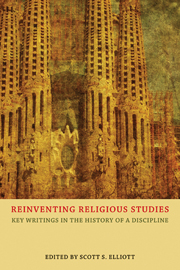Book contents
- Frontmatter
- Contents
- Introduction
- 1 For such a time as this: the Council of Societies for the Study of Religion, 1969–2009
- Part I Inventing and reinventing the field of religious studies
- Part II Method and theory in religious studies
- Part III Teaching religion
- Part IV Women and the bible in religious studies
- 20 For the advancement of my career: a form critical study in the art of acknowledgement
- 21 Women's studies in religion
- 22 The debut of the Bible as a pagan classic
- 23 Bible and religion
- Part V Religion and religious studies in civic life
- Part VI Religious studies and identity politics
- Part VII Islam and 9/11
- Bibliography
- Acknowledgments
- Index
22 - The debut of the Bible as a pagan classic
from Part IV - Women and the bible in religious studies
- Frontmatter
- Contents
- Introduction
- 1 For such a time as this: the Council of Societies for the Study of Religion, 1969–2009
- Part I Inventing and reinventing the field of religious studies
- Part II Method and theory in religious studies
- Part III Teaching religion
- Part IV Women and the bible in religious studies
- 20 For the advancement of my career: a form critical study in the art of acknowledgement
- 21 Women's studies in religion
- 22 The debut of the Bible as a pagan classic
- 23 Bible and religion
- Part V Religion and religious studies in civic life
- Part VI Religious studies and identity politics
- Part VII Islam and 9/11
- Bibliography
- Acknowledgments
- Index
Summary
If culture is tradition, education tradition formalized, and pedagogy education in practice, then a change in pedagogy—at any point—is a change in culture; and a change in the pedagogy enshrining a major cultural artifact like the Bible is, potentially, a major cultural change. As the Bible moves out of explicitly religious institutions—parochial schools, yeshivas, seminaries, denominational universities, etc.—and into the state universities of North America, what changes are likely to take place in the process by which it is transmitted? If, for example, the Old and the New Testament are to be taught in the manner in which a conventional classicist—say, Gilbert Highet—teaches the Iliad and the Odyssey, will they be differently taught?
The answer to such a question entails re-vision, in the sense in which culture-historian William Irwin Thompson likes to use that word, both of the Bible and of the institutions which enshrine it. For this reason, the reference to Gilbert Highet is not idle. The Homeric literature with which he is particularly associated was once the sacred scripture of a living religion. The religion is now dead; the scripture survives, caught up in a new civilization. If the Bible can now be taught as if it were the Iliad, are we to conclude that Judaism and Christianity are now as dead as Greek paganism? If indeed they are that dead (surely a conclusion not lightly to be drawn), what are the prospects that their sacred scriptures can make what we may call the Homeric transition?
- Type
- Chapter
- Information
- Reinventing Religious StudiesKey Writings in the History of a Discipline, pp. 130 - 139Publisher: Acumen PublishingPrint publication year: 2013



